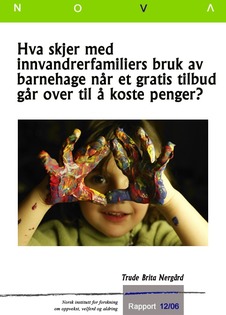| dc.contributor.author | Nergård, Trude B. | |
| dc.date.accessioned | 2020-06-07T21:05:13Z | |
| dc.date.accessioned | 2021-04-29T13:50:28Z | |
| dc.date.available | 2020-06-07T21:05:13Z | |
| dc.date.available | 2021-04-29T13:50:28Z | |
| dc.date.issued | 2006 | |
| dc.identifier.isbn | 82-7894-241-2 | |
| dc.identifier.issn | 0808-5013 | |
| dc.identifier.uri | https://hdl.handle.net/20.500.12199/3223 | |
| dc.description.abstract | The report deals with how the use made of a service changes when it switches from being free to being charged for. In autumn 1998 a trial scheme started involving fours hours of free day care centre provision for all five-year-olds in a district of Oslo known as "Gamle Oslo”. The trial scheme was subsequently extended to include four-year-olds. The aim was to get more children with an immigrant background to start at a day care centre, and to lay a basis for improved integration and language training. The formal trial ended after three years, but the free day care provision scheme continued until June 2004. This project focuses on the first year after the free day care provision scheme ceased, specifically on what happened with the children who attended the experimental day care centre[1] and on what use was made of day care provision in the two age groups encompassed by the scheme. The data were compiled in autumn 2004 and spring 2005. The main focus is on families with an immigrant background. Virtually all children attending the experimental day care centre had such a background. All children who attended the experimental day care centre and who did not start school in autumn 2004 were offered the option of continuing on a new short-term programme with the same opening hours as previously and with many of the same staff. About half of the children accepted the offer, while some opted to continue at other day care centres in the district. For a number of families, however, the change in the free-of-charge scheme appears to have broken the continuity of day care centre attendance. In the case of some families the break lasted perhaps just a few months, for others it probably brought an end to day care centre attendance. Of the coming first graders[2] (five-year-olds) in the district known as Gamle Oslo, by far the majority were attending day care centre at the time of enrolment (September/October 2004). But at the school with the highest proportion of pupils with an immigrant background, a quarter were without a place at a day care centre. All were minority-language children. Similarly, about a quarter of the four-year-olds attending mother and child health clinics in Norway for health checks in the period August 2004 to March 2005 were without a place at a day care centre. Apart from a few children of families with a so-called "mixed background” (one ethnic Norwegian parent and one parent from another country), all came from families with an immigrant background. In the period the free day care provision scheme was in operation, "all” four and five-year-olds are said to have attended a day care centre in the district of Gamle Oslo. While poor finances are the commonest reason for four-year-olds not attending day care centre, this only applied to just over a quarter of all children not attending day care centre. A relatively large group have applied for and are awaiting a place, while almost as many say they do not desire a place at a day care centre. [1] The Norwegian term («forsøksbarnehagen») is the same as the one used in the three previous evaluations of the trial scheme, cf. NOVA Report No. 3/2002 and NOVA Report No. 6 and 7 /2003. [2] Children due to start school in autumn 2005. | en |
| dc.description.abstract | Høsten 1998 startet et forsøk med fire timers gratis barnehage for alle femåringer i bydel Gamle Oslo. Senere ble dette utvidet til også å omfatte fireåringene. Målet var å få flere barn med innvandrerbakgrunn til å begynne i barnehage, og å legge til rette for bedre integrering og språkopplæring. Det formelle forsøket opphørte etter tre år, men gratisordningen fortsatte fram til juni 2004. Så godt som alle som fikk tilbud om gratis barnehageplass, takket ja. I dette prosjektet ser vi hva som skjedde det første året etter at gratisordningen opphørte - med barna som gikk i forsøksbarnehagen og med bruken av barnehage i de to aldersgruppene som ordningen omfattet. Det er først og fremst familier med innvandrebakgrunn vi er interessert i. Samtlige i forsøksbarnehagen hadde slik bakgrunn. Hvor mange av dem fortsatte i barnehage? Hvor mange av den nye generasjonen fireåringer går i barnehage? Dataene som prosjektet bygger på ble samlet inn høsten 2004 og våren 2005. | no_NB |
| dc.publisher | Oslo Metropolitan University - OsloMet: NOVA | |
| dc.relation.ispartofseries | NOVA Rapport 12/06 | |
| dc.subject | NOVA | |
| dc.title | Hva skjer med innvandrerfamiliers bruk av barnehage når et gratis tilbud går over til å koste penger? | no_NB |
| dc.type | Report | |
| fagarkivet.source.pagenumber | 82 | |
